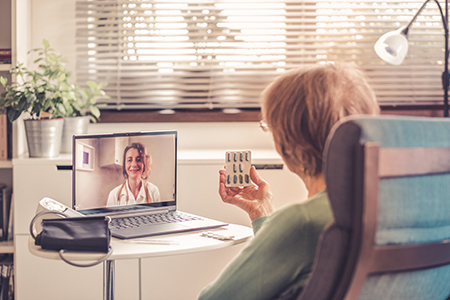Telemedicine

Telemedicine is the use of technology such as computers and mobile devices to help you get health care anywhere and anytime.

You can talk directly with a board-certified doctor through the phone or video to help with minor, non-life-threatening conditions. When medically necessary, the provider can have prescriptions sent directly to your local pharmacy. Current medical analysis indicates that more people are using telemedicine than ever before; this is a healthcare delivery method that is here to stay.
The Centers for Medicaid and Medicare Services (CMS) gave the green light to telehealth, and a virtual explosion in usership ensued. Institutions such as Nemours Children’s Health System, Massachusetts General Hospital, and NYU Langone have documented a huge surge in virtual visits compared to pre-COVID19. State authorities and local governments urged patients to utilize telemedicine instead of seeking traditional care at doctor’s offices, clinics, and hospitals to quell the spread of the virus.
The key benefit of telehealth during the COVID19 pandemic has been the providers’ ability to maintain the continuity of care for patients with chronic diseases. Telemedicine has allowed providers to assess if patients with an acute diagnosis can be medically managed in their homes or if they need to be brought in for further testing and evaluation.

Making the Most of Your Telemedicine Appointment
To get the most out of a remote visit with your doctor or health care provider, ideally, you should have the following:
- A phone
- A good internet connection
- Video access through a smartphone, tablet, or computer
- The providers preferred app, downloaded before the visit

What Services Can Be Provided Via Telehealth?
Noncritical visits that do not rely heavily on detailed physical exams or in-office diagnostic testing. The list includes:
- Allergies
- Colds and flu
- Fever
- Headaches
- Rashes
- Sore throats
- Stomach pain
- Urinary tract infections
Telehealth can also be used for follow up appointments for chronic conditions and medication management for conditions such as diabetes and high blood pressure.
Mental health services and counseling is another service that heavily utilizes telemedicine as it is usually talk-based. Mental health services typically require no hands-on care, making these services especially well-suited for remote delivery.
For patients that live in rural areas, telehealth can provide them access to specialists at large institutions after their primary care provider provides an assessment.

Preparing for a Telehealth Visit
Make sure your paperwork is filled out in advance; this includes insurance information and health history. Have the information on hand that your doctor will need depending on what type of visit. For example, if you have an appointment for diabetes management, make sure to forward your doctor your blood sugar record before the call.
If you have a skin rash, abrasion, or cut, take a picture so that the doctor can more closely examine it as part of your appointment.
Make a list of any symptoms you have and prepare a list of questions. Have a list of the current medications you are taking or the actual prescription bottles, so there is no mistaking what you are taking and the dosage.
Check with your insurance company. Many rules surrounding telehealth have changed rapidly. It’s best to double-check ahead of time with your health insurance provider that they will cover the service you’re seeking to receive via your telehealth visit.
Before your appointment, double-check your equipment:
- Check that the volume is up.
- Camera access has been granted to the appropriate application before the call starts.
- Have a pen and paper ready to jot down recommendations the provider might have.
Think about the setting. Do your best to find a quiet, well-lit corner to have your visit. Do not sit outside as noise and lighting can interfere with the quality of video and sound.
Consider having someone else join you. Depending on the type of visit you’ll be having and what will be discussed, it might be helpful to have a family member sit in on the call with you. They can help take notes or to raise other concerns with the provider if you forget something.
Focus on the session. Just as you would during an office visit, eliminate distractions and interruptions during the virtual visit and give your provider your undivided attention. Shut off notifications on your cell phone and shut down apps that might create distractions or noise.

Common Telemedicine Platforms
Before your appointment, make sure that your primary care provider sends you a link and instructions on their preferred telehealth platform. Below are some common platforms that are utilized.
- Zoom for Healthcare
- Skype
- Doxy.me
- Teladoc
- Amwell
- Doctor on Demand
- MDLIVE
The critical thing with telemedicine is finding a means of communication that works best for you and your provider.

More Information on Telehealth
Contact your health insurance provider for information. You can also review information on The National Consortium of Telehealth Resource Centers. They have created a page of additional information and resources specific to the COVID-19 pandemic to help guide you through any additional questions or concerns you may have regarding telehealth services.

Referenced
CMS.gov, “Medicare Telemedicine Care Provider Fact Sheet”
Accessed at https://www.cms.gov/newsroom/fact-sheets/medicare-telemedicine-health-care-provider-fact-sheet
MDLink. “Will Doctor Visits Ever Be the Same Again After COVID-19?”
US News. “A Beginners Guide to a Virtual Doctor’s Visit”
Accessed at https://health.usnews.com/conditions/articles/a-beginners-guide-to-a-virtual-doctors-visit
Download the Free Resource
Access a printer-friendly version of the resource to reference later.